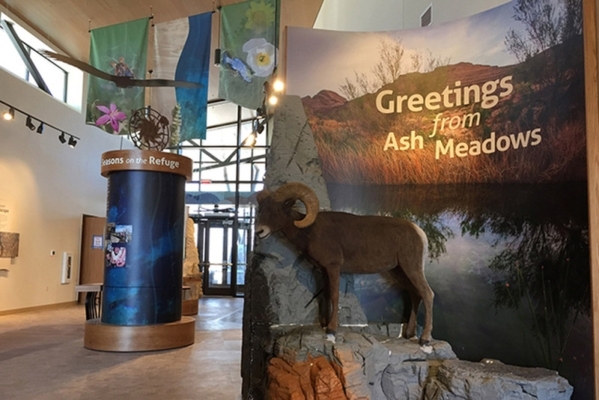Ash Meadows home to rare plants, animals

The largest remaining oasis in the Mojave Desert, Ash Meadows National Wildlife Refuge invites visitors to explore distinctive environments that are home to plants and animals found nowhere else on Earth. The 24,000-acre refuge protects 27 endemic species, including tiny fish species that have inhabited warm water springs at Ash Meadows since the last ice age.
A drive of about an hour and a half from Las Vegas will take you to the refuge not far from Death Valley. It is open from dawn to dusk free of charge. Use either U.S. Highway 95 north to state Route 373 at Lathrop Wells or south on Interstate 15 to state Route 160, the road to Pahrump. Using U.S. 95, drive south 14 miles from Lathrop Wells to the refuge’s main access road, then four miles to the refuge boundary.
If you follow Route 160 to Pahrump, continue north to Bell Vista Road, turn left and head west toward Death Valley Junction, turning right toward the refuge just over the California-Nevada border near Longstreet Casino. You will pass an unpaved entrance road before you reach Death Valley Junction that will take you north into the refuge. A high-clearance vehicle is best on this approach.
Ash Meadows is close enough for a day trip during any season. It is especially inviting during autumn and spring. Fall colors still linger among the native ash trees, other shrubs and late wildflowers. Spring arrives after a short winter with a flush of green foliage and colorful wildflowers by late February or early March. Summers at Ash Meadows are green, but long and too hot for comfort except in early morning.
Now internationally recognized as an ecological hot spot, Ash Meadows is home to endemic species of animals and plants, most of them threatened or endangered. These include a few kinds of tiny desert fish adapted to life in the area’s warm springs. Refuge visitors can observe the playful fish in several of the area’s springs, accessed by trails and boardwalks to protect the fragile desert soils.
President Harry Truman signed a proclamation in 1952 to protect the Devil’s Hole pupfish, the rarest fish on Earth. Its sole habitat on a shallow ledge in a deep underwater crevice was set aside and entrusted to the National Park Service in nearby Death Valley for protection. Devil’s Hole now lies within Ash Meadows NWR but remains part of Death Valley National Park. The strange site is fenced off for safety. After a sharp decline of the pupfish population, a new facility where fish eggs are hatched and fish raised to adulthood was built at Ash Meadows to further protect the species.
Once threatened by agricultural use of its water, mining its soils for peat and proposed construction of commercial and residential developments, Ash Meadows is being restored under management of the U.S. Fish & Wildlife Service. Following studies of the Devil’s Hole pupfish and other wildlife and plants, Ash Meadows was designated a refuge in 1984. It is part of the Desert Wildlife Refuge Complex, which includes four Southern Nevada refuges.
A fine visitor center, which opened last December, welcomes people to Ash Meadows and provides an introduction to the preserve. Already popular with birders, photographers and visitors to nearby Death Valley, the refuge saw visitation double within the first few months after the new facility was opened. The visitor center is open daily from 8:30 a.m. to 4 p.m.
An excellent introductory film is shown in the center’s theater. Wall decorations depict the kinds of fossils found at the site. Interactive displays and exhibits show area plants and animals, including some of the 300 bird species spotted there. Other exhibits describe the lives of native cultures that called Ash Meadows home for hundreds of years.
At Point of Rocks, walkways reveal native campsites among mesquite thickets and visitors frequently see many birds, as well as desert bighorn sheep atop nearby outcroppings.
Call 775-372-5435 for details of guided hikes in December to sites such as lovely Crystal Spring behind the visitor center or Crystal Reservoir, the best place to see shore birds and waterfowl.
— Margo Bartlett Pesek’s Trip of the Week column appears on Sundays.












